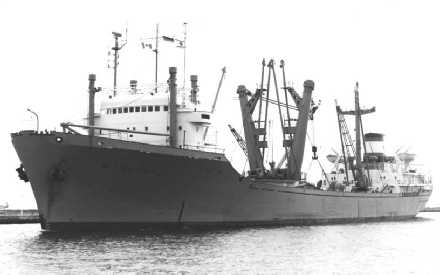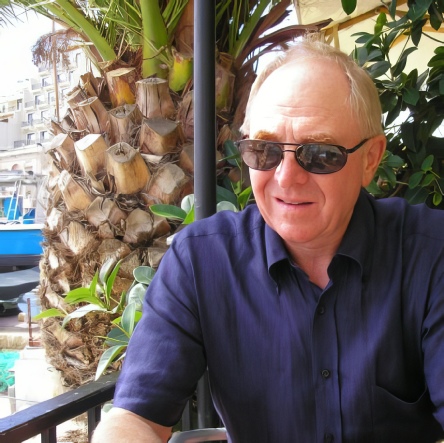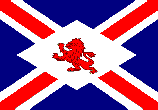British & Commonwealth operated an exchange scheme with a German shipping company Deutsche Dampfschifffahrts-Gesellschaft Hansa of Bremen - Hansa Line for short. So I wrote to personnel department, was accepted onto the scheme and joined the Werdenfels in Rotterdam in July 1963.
This was something just a bit special. In the Clan line their ships had not really moved on technologically since the second world war. In Hansa Line everything, but everything was leading edge.
Instead of a traditional heavy lift derrick which struggled to lift 150 tons the Werdenfels was equipped with a modern “Stulken” Derrick that lifted more than 200 tons.
Instead of chugging around the ocean at 15 knots we positively rocketed around at 19. There were 12 passengers. The bridge was on the focs’le and on the well deck there were 5 ton cranes which moved fore and aft on rails. On the ships bridge Hansa Line supplied superb Plath sextants and Steiner binoculars. Etc.
Equipment therefore good, people more challenging. The Captain, Herr Kapitan Fooken, a tall imposing figure, had been in a prisoner of war camp in Port Sudan, together with the Chief Engineer and the Electrician for a good part of the 2nd World War.
Not much love for a British cadet there then. The second officer’s father had been obliged to avoid pot shots from Polish partisans when running a Messerschmitt factory in Poland (so the story went) and the third officer could best be described as a committed Nazi. Against that the Chief Officer, Herr Öhletz, to whom I reported was human, highly competent and friendly and my colleague, Hans Kolbe, the German cadet positively fun to work with.
The only similarity was that we had English speaking Indian crew – so instantly easy to work with after my time in Clan Line. Even a bit of Malim Sahib’s Hindi.
Our destination was different. Hansa Line’s Liner trades were from Europe and the USA to the Persian Gulf. So after Marseilles, Genoa and a brief sojourn picking up heavy boilers in La Spezia it was through the very familiar by now Suez Canal but turn left outside the Red sea and first stop an anchorage off Dubai.
At this stage there was no port in Dubai and there was a hangover of the Raj in that the Gulf Emirates were still under the governance of Great Britain.
In 1963 Dubai was a mosquito ridden creek, of no great beauty. The far sighted Ruler was in the process of having the creek dredged and this then enabled trade to be developed. The airport was a compacted sand strip. Oil was not produced there until 1966.
The boilers were destined for a new power station and were discharged courtesy that famous colonial British entity “Grey Mack’s” onto flat barges towed out to the anchorage by tug.
And that was that for Dubai.
Next stop Dammam in Saudi Arabia. At this time the port of Dammam was at the end of a very long pier which connected to the railway line to Riyadh. One ship could berth at each side of the pier. The ships alcohol stores had to be sealed although I don’t recall being prevented from drinking the beer etc. that we had already purchased. And talking of beer – a case of 24 cans of Becks or Loewenbrau cost DM11.20 and the exchange rate was DM4.20 to the £ sterling.
It was a pretty miserable port to be in. No run ashore, working cargo 24 hours a day in blistering heat during the day and extreme humidity at night. When working cargo round the clock I had the night cargo watch with the second officer from 6pm to 6 am and at sea I was on the 12 – 4 watch. Cargo watches consisted of making sure that the right cargo was removed from the correct deck of the correct hatch and ensuring that nothing was left behind. We were expected to keep an eye on the dockers to prevent cargo being stolen – not easy when whisky etc. was loaded in unprotected cardboard cartons on pallets. We would solve any technical problems when dockers used the ship’s cranes. And to do all this cargo work we had to climb up and down the ladders inside the hatches – sixty feet or so from the top of the hatch to the bottom. It was hot, sweaty, grubby work.
That voyage continued round the Gulf, firstly to Kuwait but then up the Shatt al Arab – the river formed by the confluence of the Tigris and Euphrates. We went to three ports – Basrah in Iraq, Khorramshar and Abadan. Basrah and Khorramshar were good for swimming pools open to visiting ships officers.
Being on the night cargo watches I would manage to get a swim in every day. Temperatures were fierce – 50 in the shade in the daytime led to the cargo hatches absorbing the heat all day and providing no cool relief at night. At night the rapid drop in temperature (to maybe 30 – 35 degrees) meant that there was very high humidity. We wore khaki uniform – shorts, knee socks, shirts with epaulettes which were sodden with sweat after a few hours. On one night cargo watch in Khorramshar I remember getting through three sets of uniform. Fortunately with our Indian crew came servants and a laundry so the minute anything was dirty off it went with the steward returning clean and crisp 24 hours later.
At sea I had taken to drinking iced tea on bridge watch – and I can remember getting through a gallon one night whilst navigating our way through the Gulf.
By Khorramshar we had discharged most of the cargo and started loading. The only thing I remember about this was 40 tons of Caviar destined for New York. All was carefully loaded into refrigerated compartments – it was probably as valuable as the gold bullion shipped in Union-Castle mail ships from South Africa.
There was a brief stop in Bushir and then back to Kuwait and then Bahrain. Bahrain was interesting. A friend of my fathers was in charge of the Bahrain Police Force and he took me out to the old fort. We lay alongside the one pier – cargo ship one side and the Royal Naval Tribal class Frigate on the other. It was an interesting reflection when I returned to work in Bahrain 30 years later.
We were then off to the USA via Mediterranean ports. The most notable of these was Beirut for a number of reasons. The first was the storm that we encountered just before arrival. The slamming at the bow was so severe that the preventer on the starboard anchor cable broke and the starboard anchor and cable was lost overboard. Beirut was an eye-opener when compared to the strictly Muslim Arabian Gulf. I met an American family – the husband was teaching at the American University of Beirut and Hans and I were invited home. We walked down to Saint Georges beach, well populated with curvaceous young Lebanese girls. We also took a day off to visit Baalbek. That was notable for a number of reasons. We had asked the ships agent to fix us a car and a driver. We were greeted by an open top Pontiac with a bonnet that looked about as long as an aircraft carriers flight deck. And then the site itself was wonderful. It would be a treat to go back to revisit Baalbek but the current political situation in Lebanon means that currently this is unlikely.
The only other item of interest on the way out of the Mediterranean was a call at Livorno where we picked up (literally using our heavy lift gear) three 150 tonne rail cars bound for the “Ferrocarril Chihuahua al Pacifico”.
And then across the Atlantic.
The arrival in New York was stunning. We picked up the loom of the lights of New York from a hundred miles away and then made our way to Ellis Island to clear immigration and customs.
In addition to watchkeeping Hans and I were responsible for all the ships customs clearance and immigration paperwork. So we were both up to greet shore officials on entering harbour. In most places it was pretty relaxed and easy process. Not New York. In those days immigration was still centred on the –now famous – Ellis Island just opposite the statue of Liberty and we anchored there to complete the formalities. Every crew member had to be checked against the illegal aliens list. There are a limited number of Indian surnames – most of which featured on the prohibited immigrant list. So all the crew had to be inspected. It took six hours. We had started off by giving the customs officials a beer and then another beer – by the time we were finished they were close to paralytic. The final comment was when they had finished with all the German and Indian crew and got down to me, the only Englishman on the boat. I presented my British Seafarers registration document and was told that “I didn’t half speak good English for a Kraut”.
Our first call after immigration was New Jersey – where we were berthed miles away from civilisation in a pretty drab dockside. We decided that a run ashore would be appropriate and I was designated to work out how. Eventually we got to a bus stop and – as the native English speaker (and this was the early sixties where it wasn’t necessarily good to be German in the USA) I was again put in charge of buying tickets etc. I realised just how immersed in the German language the last three months had been when I said words to the effect “does this bus to the town go”.
I had worked quite hard at speaking German. The problem was that all the ships officers had to learn English for their professional exams – and so they wanted to speak English to me all the time. After a few months I realised that I wasn’t getting enough practice in German and so went to the Captain and suggested that from then on I would only take any orders or instructions in the German language. I got a very old fashioned look from the captain but he agreed. Chaos followed for a while but my rate of learning German picked up rapidly.
We then worked our way gradually down and then back up the East coast of the USA & Mexico. Philadelphia, Norfolk Virginia, Wilmington North Carolina, Jacksonville Florida, Brownsville Texas, Tampico Mexico, Houston Texas, New Orleans, Charleston, back to Philadelphia and New York.
If it sounds like a rapid schedule its because it was. A few memories remain though. When we sailed past Norfolk Virginia there were vast numbers of battleships and aircraft carriers laid up in reserve. Sailing south past Cape Hatteras we went through a huge shoal of hammerhead sharks. In Brownsville Texas I went ashore to buy a string for my guitar (of which more later) and on asking for the string a gorgeous Texas blonde girl told me “y’all do speak English funny”. In Tampico there was Latin music, trumpets, mariachis till late at night – we unloaded the rail cars and then left. We went up the Mississippi river to Baton Rouge handled cargo for a few hours and then sailed back down to New Orleans where we had a night to go ashore. I managed to get to Preservation Hall to hear traditional New Orleans Jazz.
Most interesting though was New York where we spent a few days. I bought my first blues LP records – Sonny Terry and Brownie McGhee on one and Lightnin Hopkins the other. I was invited up to and spent a night near Vassar College in Poughkeepsie NY by a pen friend of one of the crowd I hung around with at the Blundellsands Sailing Club. Taking the train up alongside the Hudson was a truly memorable experience.
I played chess in Washington Square and was picked up by a girl who was a nude model for New York university art classes and presented me with Dostoevsky novel – I can’t remember which one. I went to Gerdes Folk City in Greenwich Village and heard some of the (1963 remember) developing American folk blues scene. The place was nearly empty and all I can remember was that a clearly well known female singer called Joanie was in the club and invited to do a guest spot – maybe Joan Baez but I would be guessing. I love New York.
The final memory of that New York visit was that on November 22nd, 18 hours out of New York en route to the Persian Gulf and with a full complement of 12 American passengers we got the news of the assassination of John F. Kennedy. A heart stopping moment and I was delegated, as the sole Englishman on board, to personally inform each passenger.
Our return to the Gulf by now was routine and more or less mapped the ports we visited on my previous voyage. It was winter, Christmas on the pier at Dammam working cargo in sandstorms was not much fun although the Saudis seemed to have turned a blind eye to the amount of alcohol left in peoples cabins.
The only different stop was that we went to Karachi – my first visit to Pakistan and I had two runs ashore. One was to pay my respects to a friend of my Uncle Len’s, an extremely wealthy man called John Cowasjee. I was picked up, ushered into his dark and gloomy office, chatted to for a while and then taken back to the ship. The second was a bit of sailing at the Karachi Yacht club where uncle Len had been a member.
Then it was back to the Suez Canal where I was due to change ships and take the Hohenfels back to Rotterdam. The change was due to the fact that I had completed enough sea time to be allowed to take my first professional certificate.
I had qualified as an able seaman, able to drive a lifeboat whilst at Warsash. Now I had to go ashore, study and then pass the famously fierce exams for a “foreign going” second mate’s ticket.
After getting my degree from Plymouth I joined Williams & Glyn’s Bank as a “City Division” graduate trainee. After General Banking training I specialised in Shipping finance, moved to Grindlays - ultimately acquired by ANZ Bank of Australia and retired from ANZ as General Manager of an Offshore Banking Unit in Bahrain and Country Head for Bahrain, Saudi Arabia, Oman and Kuwait.
I had a post retirement job as London representative for a middle eastern bank, was chairman of the International Bankers representative offices committee.
I’m now retired and active as an International Sailing Federation “International Judge” and very active in judging international regattas – currently the Barcelona Round the World Race.






